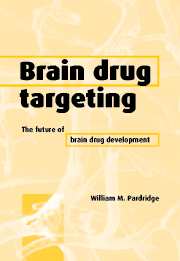Book contents
- Frontmatter
- Contents
- Preface
- List of abbreviations
- 1 Drug targeting, drug discovery, and brain drug development
- 2 Invasive brain drug delivery
- 3 Lipid-mediated transport and carrier-mediated transport of small molecules
- 4 Receptor-mediated transcytosis of peptides
- 5 Vector discovery: genetically engineered Trojan horses for drug targeting
- 6 Linker strategies: the engineering of multifunctional drug formulations
- 7 Protein neurotherapeutics and peptide radiopharmaceuticals
- 8 Antisense neurotherapeutics and imaging gene expression in vivo
- 9 Gene therapy of the brain
- 10 Blood–brain barrier genomics
- References
- Index
- Plate section
8 - Antisense neurotherapeutics and imaging gene expression in vivo
Published online by Cambridge University Press: 08 January 2010
- Frontmatter
- Contents
- Preface
- List of abbreviations
- 1 Drug targeting, drug discovery, and brain drug development
- 2 Invasive brain drug delivery
- 3 Lipid-mediated transport and carrier-mediated transport of small molecules
- 4 Receptor-mediated transcytosis of peptides
- 5 Vector discovery: genetically engineered Trojan horses for drug targeting
- 6 Linker strategies: the engineering of multifunctional drug formulations
- 7 Protein neurotherapeutics and peptide radiopharmaceuticals
- 8 Antisense neurotherapeutics and imaging gene expression in vivo
- 9 Gene therapy of the brain
- 10 Blood–brain barrier genomics
- References
- Index
- Plate section
Summary
Introduction
Types of oligodeoxynucleotides
The three most widely utilized classes of oligodeoxynucleotides (ODNs) are phosphodiester (PO)-ODN, phosphorothioate (PS)-ODN, and peptide nucleic acids (PNA), as outlined in Figure 8.1. Antisense ODNs are agents that have the potential to be a new class of neurotherapeutics or neurodiagnostics, should these molecules be made transportable through the blood–brain barrier (BBB). Antisense ODNs hybridize to target mRNA molecules in brain cells via sequence-specific mechanisms based on Watson–Crick base pairing and hydrogen bonding. Therefore, antisense agents could act as neurotherapeutics by binding to a specific target mRNA and eliminating the production of that gene product. Antisense ODN molecules could also be used as radiopharmaceuticals for imaging gene expression in the brain in vivo.
Antisense agents as neurotherapeutics
The neurodegenerative disease that might by most amenable to antisense therapy is Huntington's disease (HD). The HD gene was identified in 1993 and encodes a 343 kDa protein, designated huntingtin, which has polyglutamine repeats owing to a CAG repeat in the huntingtin transcript (Huntington's Disease Collaborative Research Group, 1993). The greater number of CAG repeats in the huntingtin gene and transcript, and the greater number of glutamines added to the huntingtin protein, then the greater the severity of the disease (Gutekunst et al., 1995). Polyglutamine repeats are found in a number of transcription factors and serve as binding sites for protein–protein interactions (Stott et al., 1995). For example, glyceraldehydes phosphate dehydrogenase (GAPDH) binds polyglutamine repeats, and GAPDH mRNA increases prior to cellular apoptosis (Burke et al., 1996). Therefore, the polyglutamine repeats in the huntingtin protein could trigger binding of the GAPDH which could lead to an increase in GAPDH mRNA production and induce apoptosis.
- Type
- Chapter
- Information
- Brain Drug TargetingThe Future of Brain Drug Development, pp. 221 - 250Publisher: Cambridge University PressPrint publication year: 2001

